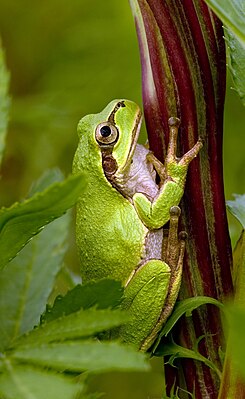Japanese tree frog
| Japanese tree frog | ||||||||||||
|---|---|---|---|---|---|---|---|---|---|---|---|---|

Japanese tree frog ( Dryophytes japonica ) |
||||||||||||
| Systematics | ||||||||||||
|
||||||||||||
| Scientific name | ||||||||||||
| Dryophytes japonica | ||||||||||||
| ( Günther , 1859 (1858)) |
The Japanese tree frog ( Dryophytes japonicus , synonym : Hyla japonica ) is a species of frog from the genus Dryophytes in the family of tree frogs iw S.
features
The Japanese tree frog is a small frog with a head-torso length of 30 to 52 millimeters. Its eyes are larger than the diameter of the eardrum. The mostly green upper side of the body is smooth-skinned, while the whitish underside is fine-grained and granulated. A dark vertical stripe runs along the flanks, which breaks down into regular pattern of spots and can be partially reduced. The Japanese tree frog is very similar to the European tree frog ( Hyla arborea ). This also applies to the external distinction between males and females, which focuses on the color of the throat: In males, the throat is brownish and wrinkled - due to the vocal sac located there - while in females it is smooth and light. In contrast to Hyla arborea , the Japanese tree frog has a dark patch on the upper lip below the eye, a so-called "hip loop" is missing and the hind legs are comparatively short.
A female produces 341 to 1448 eggs in the year. The clutch consists of single or a few spawning balls , each containing 5 to 100 eggs. The diameter of the eggs is 1.1 to 1.5 millimeters without the egg shell and 3.3 to 5.5 millimeters with the egg shell. The tadpoles have a total length of 4 to 5 millimeters when they hatch. By the time metamorphosis begins , they reach a length of 35 to 45 millimeters. The viscera of the larvae is only slightly or not at all recognizable through the belly. Immediately after going ashore, the head-trunk length of the young frogs is 10 to 16 millimeters.
Occurrence
The distribution area of the Japanese tree frog includes Japan, Korea, northeast and central China, northern Mongolia and the Russian Far East to the south of Lake Baikal. In Russia the species can be found sporadically in the south of the island of Sakhalin , in South Primorye and the river valleys of the Amur and Ussuri .
Systematics
The internal systematics of the species has hardly been investigated, it is assumed that there are two or more subspecies . From Russia was Dryophytes japonicus ssp. stepheni Boulenger , 1887. This differs from the nominate form in its short lower legs. The subspecies Dryophytes japonicus ssp. ussuriensis could not be confirmed, as well as the species Hyla heinzsteinitzi , introduced in Israel , which also belongs to the species Dryophytes japonicus .
Individual evidence
- ↑ a b c d e Sergius L. Kuzmin: The amphibians of Russia and neighboring areas. In: Die Neue Brehm-Bücherei Vol. 627. Westarp Sciences, Magdeburg 1995, ISBN 3-89432-457-0
- ↑ Distribution map of Hyla japonica at iucnredlist.org
further reading
- Teruhiko Takahara, Yukihiro Kohmatsu, Atsushi Maruyama, Ryohei Yamaoka: Specific Behavioral Responses of Hyla japonica Tadpoles to Chemical Cues Released by Two Predator Species . Current Herpetology 25 (2) pp. 65-70. 2006 doi : 10.3105 / 1345-5834 (2006) 25 [65: SBROHJ] 2.0.CO; 2
Web links
- Dryophytes japonicus inthe IUCN 2012 Red List of Threatened Species . Posted by: Sergius Kuzmin, Irina Maslova, Masafumi Matsui, Fei Liang, Yoshio Kaneko, 2004. Retrieved May 28, 2013.
- Darrel R. Frost: Dryophytes-japonicus , Amphibian Species of the World: an Online Reference, Version 6.0, American Museum of Natural History, 1998-2019, accessed August 11, 2019.